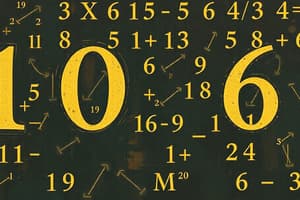Podcast
Questions and Answers
What does quantitative aptitude primarily assess?
What does quantitative aptitude primarily assess?
- Knowledge of history and geography
- Ability to understand and solve numerical problems (correct)
- Artistic talents
- Verbal communication skills
In what types of assessments is quantitative aptitude commonly found?
In what types of assessments is quantitative aptitude commonly found?
- Creative writing contests
- Music auditions
- Competitive exams and job placement tests (correct)
- Cooking competitions
What is essential for success in quantitative aptitude?
What is essential for success in quantitative aptitude?
- Advanced knowledge of literature
- Exceptional memory skills
- Strong foundation in basic math and consistent practice (correct)
- Physical fitness
What does arithmetic primarily cover?
What does arithmetic primarily cover?
Which of the following is a topic typically included in arithmetic?
Which of the following is a topic typically included in arithmetic?
What is the HCF of two or more numbers?
What is the HCF of two or more numbers?
What does LCM stand for?
What does LCM stand for?
In what base are decimal fractions represented?
In what base are decimal fractions represented?
What is involved in finding the square root of a number?
What is involved in finding the square root of a number?
What rule is essential for simplification?
What rule is essential for simplification?
What does algebra use to represent numbers and quantities?
What does algebra use to represent numbers and quantities?
Which of the following is a topic in algebra?
Which of the following is a topic in algebra?
What are algebraic expressions comprised of?
What are algebraic expressions comprised of?
What is the primary goal when solving linear equations?
What is the primary goal when solving linear equations?
What is a characteristic of linear equations?
What is a characteristic of linear equations?
Which of these is a method for solving systems of linear equations?
Which of these is a method for solving systems of linear equations?
What is the highest power of the variable in a quadratic equation?
What is the highest power of the variable in a quadratic equation?
Which method can be used to solve quadratic equations?
Which method can be used to solve quadratic equations?
Which symbol is used in inequalities?
Which symbol is used in inequalities?
What does the study of number systems help with?
What does the study of number systems help with?
Flashcards
Quantitative Aptitude
Quantitative Aptitude
The ability to understand and solve numerical problems.
Number Systems
Number Systems
Categorizes numbers based on their properties (e.g., integers, rationals, primes).
HCF (Highest Common Factor)
HCF (Highest Common Factor)
The largest number that divides two or more numbers without a remainder.
LCM (Lowest Common Multiple)
LCM (Lowest Common Multiple)
Signup and view all the flashcards
Decimal Fractions
Decimal Fractions
Signup and view all the flashcards
Square Root
Square Root
Signup and view all the flashcards
Cube Root
Cube Root
Signup and view all the flashcards
Simplification
Simplification
Signup and view all the flashcards
Algebra
Algebra
Signup and view all the flashcards
Algebraic Expressions
Algebraic Expressions
Signup and view all the flashcards
Linear Equations
Linear Equations
Signup and view all the flashcards
Quadratic Equations
Quadratic Equations
Signup and view all the flashcards
Inequalities
Inequalities
Signup and view all the flashcards
Study Notes
- Quantitative aptitude is a crucial skill assessing a candidate's ability to understand and solve numerical problems.
- It is a common section in competitive exams and job placement tests.
- The questions involve mathematical concepts and problem-solving techniques.
- Success requires a strong foundation in basic math and consistent practice.
Arithmetic
- Arithmetic covers fundamental mathematical operations and concepts.
- Topics include number systems, HCF and LCM, decimal fractions, square roots and cube roots, simplification, and approximation.
Number Systems
- Number systems classify numbers based on their properties, for example, integers, rational numbers, and prime numbers.
- Understanding number properties helps in simplifying problems.
- Divisibility rules are essential for quick calculations.
HCF and LCM
- HCF (Highest Common Factor) is the largest number that divides two or more numbers without any remainder.
- LCM (Lowest Common Multiple) is the smallest number that is exactly divisible by two or more numbers.
- Prime factorization is a common method of finding HCF and LCM.
Decimal Fractions
- Decimal fractions represent numbers in base 10, including fractions and integers.
- Converting fractions to decimals and vice versa is a key skill.
- Operations on decimals, such as addition, subtraction, multiplication, and division, are frequently tested.
Square Roots and Cube Roots
- Finding the square root involves determining a number that, when multiplied by itself, equals the given number.
- Cube root is similarly finding a number that, when cubed, equals the given number.
- Approximation techniques can speed up calculations.
Simplification
- Simplification involves applying mathematical operations in the correct order (BODMAS/PEMDAS rule).
- It includes simplifying expressions involving fractions, decimals, percentages, etc.
- Approximation is often used to find the nearest answer.
Algebra
- Algebra involves using symbols and letters to represent numbers and quantities in formulas and equations.
- Topics include algebraic expressions, linear equations, quadratics equations, inequalities, and functions.
Algebraic Expressions
- Algebraic expressions involve variables, constants, and arithmetic operations.
- Simplifying expressions, factoring, and expanding are fundamental skills.
- Understanding identities can greatly simplify complex expressions.
Linear Equations
- Linear equations involve variables to the first power.
- Solving linear equations involves isolating the variable to find its value.
- Systems of linear equations can be solved using substitution, elimination, or graphical methods.
Quadratic Equations
- Quadratic equations involve variables to the second power.
- Solving quadratic equations involves finding the values of variables that satisfy the equation.
- Factoring, completing the square, and using the quadratic formula are common methods.
Inequalities
- Inequalities involve comparing expressions using symbols like >, <, ≥, and ≤.
- Solving inequalities requires isolating the variable while maintaining the inequality.
- Special care must be taken when multiplying or dividing by negative numbers.
Arithmetic Problems
- Arithmetic problems involve practical applications of arithmetic and algebraic concepts.
- Topics include averages, ratio and proportion, percentage, profit and loss, simple and compound interest, time and work, and time and distance.
Averages
- Average is the sum of a set of numbers divided by the count of numbers.
- Weighted average considers the relative importance of each number.
- Understanding the concept of average speed in distance-time problems is essential.
Ratio and Proportion
- Ratio compares the relative sizes of two or more quantities.
- Proportion states that two ratios are equal.
- Direct and inverse proportion are important concepts.
Percentage
- Percentage represents a number as a fraction of 100.
- Converting fractions and decimals to percentages and vice versa is critical.
- Percentage increase and decrease problems are common.
Profit and Loss
- Profit is the gain made after selling a product for more than its cost price.
- Loss is the difference between the cost price and selling price when the selling price is lower.
- Calculating profit percentage and loss percentage are essential.
Simple and Compound Interest
- Simple interest is calculated only on the principal amount.
- Compound interest is calculated on the principal and accumulated interest.
- Formulas for calculating simple and compound interest should be memorized.
Time and Work
- Time and work problems involve calculating the time required to complete a task based on individual or combined work rates.
- Understanding the concept of work done per unit time is crucial.
- Problems may involve individuals, pipes filling tanks, etc.
Time and Distance
- Time and distance problems involve calculating speed, distance, or time using the formula: Speed = Distance / Time.
- Relative speed is important when objects are moving towards or away from each other.
- Problems may include trains, boats, and streams.
Data Interpretation
- Data interpretation involves analyzing data presented in the form of tables, charts, and graphs.
- Types include tables, bar graphs, pie charts, line graphs, and caselets.
- Skills in reading data accurately and drawing inferences are essential.
Tables
- Tables organize data in rows and columns.
- Understanding how to extract and compare data from tables is important.
- Calculations often involve finding averages, percentages, and ratios.
Bar Graphs
- Bar graphs use rectangular bars to represent data.
- The length or height of the bars is proportional to the values they represent.
- Comparing different categories and identifying trends using bar graphs is tested.
Pie Charts
- Pie charts represent data as slices of a circle.
- Each slice represents a proportion of the whole.
- Calculating percentages and fractions from pie charts is important.
Line Graphs
- Line graphs use lines to connect data points.
- They are often used to show trends over time.
- Analyzing the slope and direction of the lines is key.
Geometry and Mensuration
- Geometry involves properties and relations of points, lines, surfaces, and solids.
- Mensuration involves measurement of geometric figures.
- Topics include lines and angles, triangles, quadrilaterals, circles, and three-dimensional figures.
Lines and Angles
- Understanding types of angles (acute, obtuse, right, straight, reflex) is essential.
- Properties of parallel and perpendicular lines are important.
- Angle relationships (complementary, supplementary, vertically opposite) are key.
Triangles
- Classifying triangles based on sides (equilateral, isosceles, scalene) and angles (acute, obtuse, right) is important.
- Properties of triangles like the sum of angles and the triangle inequality theorem are crucial.
- Understanding congruence and similarity of triangles is essential.
Quadrilaterals
- Quadrilaterals include squares, rectangles, parallelograms, trapezoids, and rhombuses.
- Knowing properties of each type of quadrilateral is essential.
- Formulas for area and perimeter of quadrilaterals need to be memorized.
Circles
- Understanding basic terms such as radius, diameter, chord, tangent, and sector is essential.
- Properties of circles, such as the relationship between radius and diameter, are crucial.
- Formulas for area and circumference of circles need to be memorized.
Three-Dimensional Figures
- Common 3D figures include cubes, cuboids, spheres, cylinders, cones, and pyramids.
- Understanding formulas for volume and surface area of these figures is essential.
- Visualizing 3D figures from different perspectives is important.
Studying That Suits You
Use AI to generate personalized quizzes and flashcards to suit your learning preferences.




